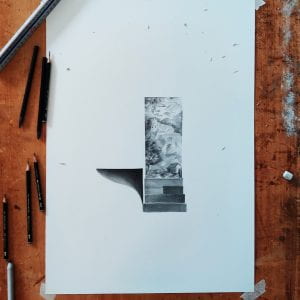“I chose Architecture for the reason most people do, I liked art and I liked maths and I didn’t want to stop doing either. Brighton’s architecture department is lucky to have some truly wonderful staff, nearly all of whom I have been luckily enough to draw from during my time there.”
Hi Ollie – can you tell us a bit about your work and your influences?
“My most recent project ‘common 165’ was about finding ways to combine interests established during academic and literature based research with themes uncovered in earlier design projects. The research which became my dissertation revealed evidence that disputes the Old Steine’s position as a commons.
“In response I created the term pseudo commons, to address this subset of public space where commons are incorrectly identified but still treated as commons. The work lends new arguments and value to the use of the term commoning to describe space. The themes established in earlier design projects were of ruin, specifically in reference to works by Soane, Piranesi, Turner and Gandy, as well the divide between Lewes’ subterranean spaces and it’s facades, with all the stories that have come to orbit them.
“Between these two works ‘common 165’ defines itself through 18th century Landscape gardens, chosen for their influence on architectural themes of ruin and deep ties to the aforementioned works as well as flections on personal experience; where claiming landscape gardens through walking became a means of establishing a greater sense of belonging during my time in Bath. The commons is imagined as an extension of residency in Lewes defined by the acts that comprise it rather than the bounds of its space.”
How have you found your course and time at Brighton?
“Throughout all my work I have explored writing as a means of design, where writing may be seen as an alternative to the drawings rather than just an accompaniment. More often than not this leaves me finding the most interest and excitement in non-architectural references; the works of geographers, writers, philosophers and poets influence me most. That said, writing is only my preferred route for discussing space, drawings and models remain a big part of my design work and model making especially is something I wish to develop further.”
“Brighton’s architecture department is lucky to have some truly wonderful staff, nearly all of whom I have been luckily enough to draw from during my time there. Their continued effort as well as the help of many others is the only reason I have been able to work through the adjustment to lifestyle the last year or so has brought.
“Architecture is an intense course, as any student of it will tell you, it is one that needs studio culture to thrive and I hope despite the disruptions that covid has brought that the university will invest in making in-person facilities readily available to oncoming students and actively encourage their use to those not fortunate enough to have experienced a year in the studios. The studios have hosted everything from indoor cricket, the most intense periods of pre hand in work, dead quite afternoons of concentrated drawing, impromptu yoga classes and crits both formal and formed in conversation between friends.”
How did you choose your course – why did you choose to study Architecture?
“I chose Architecture for the reason most people do, I liked art and I liked maths and I didn’t want to stop doing either. Its a cliché and architecture isn’t exactly between the two. First off there’s the distinction between a BSc and a BA to navigate. If you like the sound of art, literature, culture, design and history the BA will suit you best, if its engineering and a solid base in understanding how to design with construction in mind you’ll be best off with a BSc.
“Either which way I think its important to understand that the undergrad in not an introduction to being an architect – it is an introduction to what architecture might be. I started architecture thinking I wanted to be an architect and that I understood what that meant, I leave it closer to a literature student than a maths one, no less interested in architecture but in ways I could not have predicted. Read! Read what ever you can, I stumbled across a book by accident in my 1st year and it has opened my mind ever since, the libraries and their staff are outstanding.”
What are your plans after graduation?
“Currently I hope to pursue architectural academics. My intend use my year in industry to prepare for a masters course that will open up the world of research, writing and teaching in architecture.”
The node map (web human thing) sits along side the poem titled ‘trappings of present thought’. Those two along with the other poem are the ‘earlier project’. The other 3 images are from common 165.
Poems from common 165, both untitled:
1.
Tread tarnishes an out-stepped tongue,
Silvering it back to bark,
Found and fold perch,
Lends rest, makes meet and gathers,
Crest, fold falls and fills.
Below corners up ended,
Making hide and booth,
To collect stain, scratch and scuff
To wear foot
And count the passing days
2.
Bollard, proud and guarding,
A street step and path,
Between brick and under rafter.
It snows in April,
Falling like feather on the rafter,
Mulching in the rain,
The walls bear it,
Percolating past edge,
Old skin softens,
To bear it in September
Lay ones hand on cold brick,
Where floor does not,
Sit by tree and mantelpiece
Contact Ollie at Ollie_howell@outllok.com and follow him on Instagram @0llie_howell
Find out about studying Architecture BA(Hons) at Brighton.





